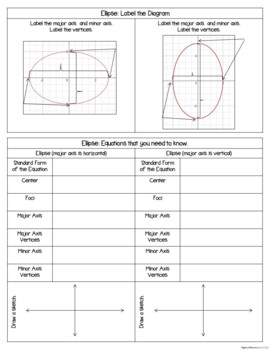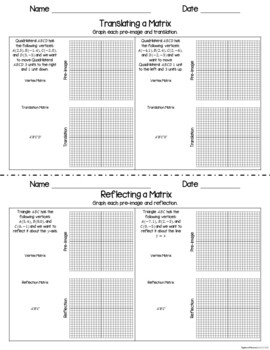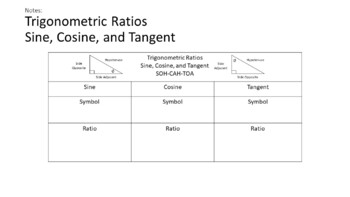Algebra 2 Guided Notes, Presentation, and INB Bundle
- Zip
Products in this Bundle (17)
showing 1-5 of 17 products
Description
This Algebra 2 Bundle is flexible, editable, and can be used for in-person or distance learning. Take the time and stress out of creating your own guided notes and presentations. There are many ways to use this engaging bundle. Students can either build interactive math notebooks with guided notes (keys included) and foldable activities OR use the included presentation note-taking handouts (keys included) with the PowerPoint presentation for focused instruction. Quick checks for understanding (keys included) help to determine how well your students understand the material as you go. Choose what works best for your class and modify to make the content fit your needs. Notes are designed to clearly present the topics and reach all types of learners.
The zip file includes BOTH editable, plain-font resources AND ready-to-print, non-editable PDFs. Suggested use guides are included. These materials may be placed on an LMS for distance learning!
Interactive Math Notebook FORMAT – Includes 3 parts: guided notes, foldable activities, and quick checks for understanding. Piece the components together and students can create their own “math textbook” in a math journal.
- Guided notes activities contain sample teacher answer keys. Example problems are solved on the sample teacher answer keys, but you can have your students use them over and over again with problems from your own curriculum.
- Interactive notebook foldable activities include descriptions for use. We have not included specific examples for the interactive notebook activities. We like to give them to students for review so that they can show what they have learned and personalize their notes.
- Quick Checks for Understanding are perfect for an entrance or exit ticket!
Presentation Sheets FORMAT – Includes 2 parts: guided notes and quick checks for understanding. They are organized in the same order as the included PowerPoint and are designed to print and present. The quick checks can be cut off the bottom of the note sheets and turned in as an assessment tool.
Presentation – Plain-font, no frills, PowerPoint presentation that you can use to present content to students whether you are in-person or remote. Slides have blank, student note templates followed by filled-in teacher keys. Modify the editable presentation to best fit your needs.
This HUGE (over 550 pages) bundle contains a full-year of focused activities for 15 units of study, perfect for Algebra 2 students. This bundle is perfect to use with any textbook or e-book curriculum and great for engaging all types of learners. You may edit each component and are free to post the content on your LMS, Google Classroom, etc. for use with your students.
Related Materials:
We also have fully editable Algebra 2 Student Practice Pages with additional practice problems for each topic. You can purchase these separately if you need additional practice problems for each unit. They are similar to the quick check sections and they are great for extra practice, homework, and remediation.
In addition we now offer fully editable Algebra 2 Assessments. These assessments include two versions of each test, perfect for a pre- and post-assessment.
Or purchase all of our Algebra 2 materials together in our Algebra 2 Curriculum Pack, which contains everything you need to teach Algebra 2!
This bundle also contains a description of how to use the materials included. In addition, we recently added a CCSS alignment guide to help you plan and prepare which you can access as a FREE download here:
Algebra 2 Supplementary Materials and Alignment Guide
Bundle contains the following individual units:
Solving Equations and Inequalities
Order of Operations (Review)
Defining Key Terms: Variables, Algebraic Expressions, and Formulas
Reviewing Expressions and Formulas
Number Systems
Properties of Real Numbers
Properties of Real Numbers (Match)
Multiplicative and Additive Inverses
Distributive Property
Verbal Expressions to Algebraic Expressions
Properties of Equality
Review: Solving Equations
Absolute Value Expressions
Solving Absolute Value Equations
Properties of Inequalities
Solve and Graph an Inequality
Compound Inequalities
Absolute Value Inequalities
Linear Relations and Functions
Relations: Domain and Range
Multiple Representations of a Relation
What is a Function?:
What do functions look like?
Create a Mapping of a Relation
Is the equation a linear equation?
State the Domain of a Function
Evaluating Functions for a Given Value
Operations with Functions
Composition of Functions
Ways to Write Equations of Lines
Writing Linear Equations in Standard Form
Types of Slope
Finding Slope
Linear Functions
Using Intercepts to Graph Lines
Graph a Line in Slope-Intercept Form
Graph a Line Given a Point and Slope
Writing Linear Equations
Equations of Parallel, Coinciding, and Perpendicular Lines
Graphing Parallel Lines
Graphing Perpendicular Lines
Correlation
Some Special Piecewise Functions
Graphing Linear Inequalities
Solving Systems of Equations in Two and Three Variables
Characteristics of Systems of Equations
What is a System of Equations?
How do you solve a system of equations by graphing?
Classifying Systems of Equations by Graphing
How do you solve a system of equations using substitution?
How do you solve a system of equations using elimination?
Multiply, Then Use Elimination
Graphing Inequalities
What is a system of inequalities?
Solving a System of Inequalities by Graphing
Solving a System of Equations (Graphing, Substitution,
and Elimination)
Systems of Equations in Three Variables
14 Steps for Solving a System of Equations in Three Variables with Elimination
9 Steps for Solving a System of Equations in Three Variables with Substitution
What is a Matrix?
What are Equal Matrices?
Adding and Subtracting Matrices
Steps for Multiplying Matrices
Multiplying Matrices
Name that Matrix
Matrices: Special Types
The Product of a Scalar and a Matrix
Modeling Motion with Matrices
What is a Vertex Matrix/Translation Matrix?
How do you Translate a Shape using Matrices?
Reflection Matrices
Rotation Matrices
How do you Complete a Reflection or Rotation of a Shape Using a Matrix?
How do you Dilate a Shape Using a Matrix?
Determinants and Multiplicative Inverses of Matrices
What is a Determinant?
Formula for Finding the Determinant of a 2x2 Matrix
Steps for Finding the Determinant of a 3x3 Matrix
Finding the Determinant of a 3x3 Matrix
Steps for Finding the Determinant of a 3x3 Matrix Using Diagonals
Finding the Determinant of a 3x3 Matrix Using Diagonals
Cramer's Rule for Two Variables
Cramer's Rule for Three Variables
Multiplicative Inverse of a Matrix
Solving Systems of Equations Using Matrix Equations in 4 Steps
Polynomials, Radicals, and Complex Numbers
What is a monomial?
What is a negative exponent?
Rules of Exponents
Simplifying Expressions with Exponents
Scientific Notation
Multiplying Numbers in Scientific Notation
Dividing Numbers in Scientific Notation
What is a polynomial?
What is the degree of a polynomial?
Polynomials: Add, Subtract, and Multiply
Multiplying Binomials Using the F.O.I.L Method
Multiplying Polynomials
Dividing a Polynomial by a Monomial
Polynomial Division (Long-Division Method)
Polynomial Division (Using Synthetic Division)
Factoring Techniques (Handout)
What is Factoring?
Greatest Common Factor
Polynomial and GCF (Match)
Factoring Polynomials (Handout)
Factoring Second Degree Trinomials with a Coefficient of One on the Second Degree Term into a Product of Binomials
Factoring Second Degree Trinomials into the Product of Binomials Using the “X” Method
Factoring Polynomials with Four or More Terms Using Grouping
Special Factoring Techniques for Polynomials with Two Terms
Square and Square Root Review with Whole Numbers
Cube and Cube Root Review with Whole Numbers
Definition of nth Root
Principal Root
Real nth Roots
Finding Roots
Simplifying Roots Using Absolute Values
Rules for Simplifying Square Roots
Finding the Square Root of a Product
Finding the Square Root of a Quotient
Multiplying Radicals
Adding and Subtracting Radicals
Multiplying Binomials with Radical Terms Using the F.O.I.L. Method
Using a Conjugate to Rationalize a Denominator
Rational Exponents and Radicals
Evaluating Expressions with Rational Exponents
Expressions with Radicals
Expressions with Rational Exponents
Solve a Radical Equation (Square Root)
Solve a Radical Equation with an Extraneous Solution
Solve a Radical Equation (Cube Root)
Solve a Radical Inequality
Solving Radical Inequalities
What is an imaginary unit?
Square Roots of Negative Numbers
Multiply Pure Imaginary Numbers
Solving Equations with Imaginary Solutions
What is a complex number?
Equate Complex Numbers
Add and Subtract Complex Numbers
Multiplying Complex Numbers Using the F.O.I.L. Method
Using a Conjugate to Divide Complex Numbers
Graphing Quadratic Functions Using a Table of Values
Finding the Y-Intercept, Axis of Symmetry, and Vertex of a Quadratic Function
Graphing Quadratic Functions Using a Table of Values, the Y-Intercept, Axis of Symmetry, and the Vertex
Maximum and Minimum Values
Solutions to Quadratic Equations
Estimating Roots After Graphing a Quadratic Equation
Solving Quadratic Equations without Factoring
Write an Equation Given Roots
Steps for Completing the Square
Solving a Quadratic Equation Using the Quadratic Formula
Solving a Quadratic Equation by Completing the Square
What can the discriminant tell you about the roots of a quadratic function?
Quadratic Functions in Vertex Form
Write a Quadratic Equation in Vertex Form
Write an Equation Given the Vertex and a Point on the Parabola
Graphing a Quadratic Inequality
Polynomial and Rational Functions
Review: Finding the Degree and Leading Coefficient of a Polynomial in One Variable
Evaluating a Polynomial Function for a Given Value
Evaluating a Polynomial Function for a Variable or Algebraic Expression
Graphs of Polynomial Functions (Handout)
Graphs of Polynomial Functions Reflection
End Behavior of Polynomial Functions
Graphs of Polynomial Functions
The Fundamental Theorem of Algebra
Write a polynomial equation with the given roots.
Find the roots of a function and graph.
Locate the zeros of a function by graphing.
Finding the relative maximum and minimum by graphing.
The Location Principle
Reviewing Polynomial Factoring Techniques
Factoring Polynomials
Solving Polynomial Functions Using Quadratic Techniques
What can the discriminant of the quadratic formula tell you about the roots of the equation?
Writing Polynomial Equations in Quadratic Form
Solve a Quadratic Equation by Completing the Square
Solve a Quadratic Equation Using the Quadratic Formula
The Remainder and Factor Theorems
Using Synthetic Division to Divide a Polynomial by a Binomial
Rational Root Theorem and Descartes’ Rule of Signs
Use Descartes’ Rule of Signs and the Rational Root Theorem to Determine the Zeros of a Function
The Rational Root Theorem and Integral Zero Theorem
Use Descartes’ Rule of Signs and the Rational Root Theorem to Determine the Zeros of a Function (Leading Coefficient Does Not Equal 1)
Solving Rational Equations
Decomposing a Rational Expression into Partial Fractions
Solving Radical Equations
Solving Radical Equations with More than One Radical
Graphing a Radical Equation
What is the distance formula for two points?
What is the slope formula for two points?
What is the midpoint formula for two points?
How do you cut the cones to make the conic sections?
Equations of Circles
Writing the Equation of a Circle Given Endpoints of a Diameter
Analyzing Equations of Circles
Circles Tangent to an Axis
Use a system of equations to find the center and radius of a circle given three points on the circle.
Ellipse: Label the Diagram
Ellipse: Equations that you need to know.
Writing the Equation of an Ellipse Given Endpoints of Axes
Writing the Equation of an Ellipse Given the Length of the Axes and the Center
Analyzing the Equation of an Ellipse (Horizontal Major Axis)
Analyzing the Equation of an Ellipse (Vertical Major Axis)
Steps for writing the equation of an ellipse in standard form when given an equation in general form.
Hyperbola: Label the Diagram
Hyperbola: Equations that you need to know.
Writing the Equation of a Hyperbola Given Vertices and the Length of the Conjugate Axis
Writing the Equation of a Hyperbola Given Vertices and Foci
Analyzing the Equation of a Hyperbola (Horizontal Transverse Axis)
Analyzing the Equation of a Hyperbola (Vertical Transverse Axis)
Steps for writing the equation of a hyperbola in standard form when given an equation in general form.
Parabola: Label the Diagram
Parabola: Equations that you need to know.
Analyzing Equations of Parabolas (Parabola Opens Up or Down)
Analyzing Equations of Parabolas (Parabola Opens Left or Right)
Steps for writing the equation of a parabola in standard form when given an equation in general form.
General Form of a Conic Section
Identify the conic section represented by each equation.
Steps for finding a rectangular equation given a parametric equation of a conic section.
Conic Section Review Sheet (2 pages)
Solving a System of Equations in Three Variables by Substitution (Review Sheets)
Rational Expressions and Equations
What is a rational expression?
Simplify a Rational Expression by Cancelling Out the GCF
Simplify by Factoring Out -1
Multiplying Rational Expressions
How do you multiply rational expressions?
Dividing Rational Expressions
How do you divide rational expressions?
How do you multiply rational expressions with polynomials in the numerator and denominator?
How do you divide rational expressions with polynomials in the numerator and denominator?
What is a complex fraction?
Simplify a Complex Fraction
Least Common Multiple of Monomials
Least Common Multiple of Polynomials
Adding Rational Expressions
Adding Rational Expressions with Monomial Denominators
Subtracting Rational Expressions
Subtracting Rational Expressions with Monomial Denominators
Adding Rational Expressions with Polynomial Denominators
Subtracting Rational Expressions with Polynomial Denominators
Terms to Know When Graphing Rational Functions
Vertical Asymptotes and Point Discontinuity
Graphing a Rational Function with a Vertical Asymptote
Graphing a Rational Function with Point Discontinuity
What is a rational equation?
Solve a Rational Equation
Why is it important to check your answers when you are solving rational equations?
What is a rational inequality?
Solve a Rational Inequality
Exponential and Logarithmic Functions
Review: Properties of Exponents
Simplifying Exponential Expressions
Evaluating Exponential Expressions
Radicals and Rational Exponents
Graph an Exponential Function
Graph an Exponential Inequality
Formulas: Population Growth/Decline and Value of Investments
What is e?
Formulas with e: Exponential Growth/Decay (e)/Continuously Compounded Interest (e)/Compound Interest
Logarithmic Functions
Converting between Logarithmic and Exponential Functions
Properties of Logarithms
Common Logarithms
Expanding Expressions with Common Logarithms
Change of Base Formula
Using Logarithms to Solve Exponential Equations
Natural Logarithms
Converting Logarithms to Natural Logarithms
The Inverse of Ln
Use a Natural Logarithm to Solve an Exponential or Logarithmic Equation.
Formula: Doubling Time of an Investment
Parts of an Angle (Match)
Positive and Negative Angles
Standard Position
Quadrantal Angles
Measuring Angles in Degrees, Minutes, and Seconds
Expressing Decimal Degree Measures in Degrees, Minutes, and Seconds
Determine the Angle Measure of a Clockwise Rotation Around the Coordinate Plane
Determine the Angle Measure of a Counterclockwise Rotation Around the Coordinate Plane
Coterminal Angles and Reference Angles
Which Quadrant is your Angle in?
Using Quadrants to Figure out Reference Angles
Find the Measure of the Reference Angle
Review of the Pythagorean Theorem
Find the Six Trigonometric Ratios for Angle A
Trigonometric Ratios (Sine, Cosine, and Tangent)
Reciprocal Trigonometric Ratios (Cosecant, Secant, and Cotangent)
Special Right Triangle Relationships
Trigonometric Ratios for 30°, 45°, and 60°
Cofunctions
Unit Circle on a Coordinate Plane
The Six Trigonometric Functions on the Unit Circle
Using the Unit Circle to Find Values of Trigonometric Functions
Trigonometric Functions of an Angle in Standard Position
Find the Values of the Six Trigonometric Functions for an Angle in Standard Position Given a Point on its Terminal Side
Using Trigonometric Functions to Solve Problems Involving Right Triangles
Frequently Used Values from the Unit Circle
Inverses of Trigonometric Functions
Solve an Equation Using the Inverse of Trigonometric Functions
Evaluate an Expression with an Inverse Function Multiplied by a Function
Solve a Right Triangle Using Trigonometric Ratios and the Pythagorean Theorem
The Law of Sines
Formulas for Finding the Area of Triangles (Given Two Sides and an Angle Measure)
Formulas for Finding the Area of Triangles (Given Two Angles and a Side Measure)
The Law of Cosines
Hero’s Formula
Graphing Trigonometric Functions
Radians
Radian Measures and Their Degree Equivalents
Length of an Arc
Area of a Circular Sector
Angular and Linear Velocity
Properties of the Graph y = sin x
Properties of the Graph y = cos x
Finding the Amplitude and Period of Sine and Cosine Functions
Phase Shifts
Midline
Vertical Shifts
Graphing Sine and Cosine Functions
Properties of the Graph of y = tan x
Properties of the Graph y = cot x
Properties of the Graph y = csc x
Properties of the Graph y = sec x
Period of Trigonometric Functions
Arithmetic Sequences and Series
Terms to Know for Arithmetic Sequences
Arithmetic Sequences: Finding the Next Terms
Arithmetic Sequences: Finding the nth Term
Arithmetic Sequences: Write an Equation for the nth Term
Finding Arithmetic Means
Arithmetic Sequence vs. Arithmetic Series
Two Formulas for Finding the Sum of an Arithmetic Series
Find the Sum of an Arithmetic Series
Find the First Term in the Arithmetic Series
Find the First Few Terms in the Arithmetic Series
What is Sigma Notation?
Two Ways to Evaluate a Sum in Sigma Notation
Geometric Sequences and Series
Geometric Sequences
Geometric Sequences: Finding the Next Terms
Geometric Sequences: Finding the nth Term
Geometric Sequences: Write an Equation for the nth Term
Find a Term in the Sequence Given a Term in the Sequence and the Common Ratio
Finding Geometric Means
Geometric Sequence vs. Geometric Series
Two Formulas for Finding the Sum of a Geometric Series
Find the Sum of a Geometric Series
Finding the Sum of a Geometric Series When You are Not Given n
Find the First Term of a Geometric Series
Find the Indicated Term of a Geometric Series
What is Sigma Notation?
Two Ways to Evaluate a Sum in Sigma Notation
Finding the Sum of an Infinite Geometric Series
What is Sigma Notation?
Two Ways to Evaluate a Sum in Sigma Notation
Finding the Sum of an Infinite Geometric Series
What is Sigma Notation?
Sum of an Infinite Geometric Series in Sigma Notation
Please see individual units for detailed previews.
Related Products:
**Full-year Curriculum Packs**
Algebra 1, Geometry, Algebra 2 Curriculum Pack MEGA BUNDLE
Algebra 1 Curriculum Pack BUNDLE
Geometry Curriculum Pack BUNDLE
Algebra 2 Curriculum Pack BUNDLE
Scaffolded Notes/Interactive Notebook Bundles
Pre-Calculus Add on for Algebra 2 INB Bundle
High School Math Interactive Notebook Bundle (Algebra 1, Geometry, Algebra 2)
Student Practice Pages Bundles
Algebra 1 Student Practice Pages Bundle
Geometry Student Practice Pages Bundle
Algebra 2 Student Practice Pages Bundle
High School Math Student Practice Pages Bundle (Algebra 1, Geometry, Algebra 2)
Assessment Bundles
High School Math Assessment Bundle (Algebra 1, Geometry, Algebra 2)
**If you like what you see, please click on the "Follow Me" star to learn about new products, sales, and more!





